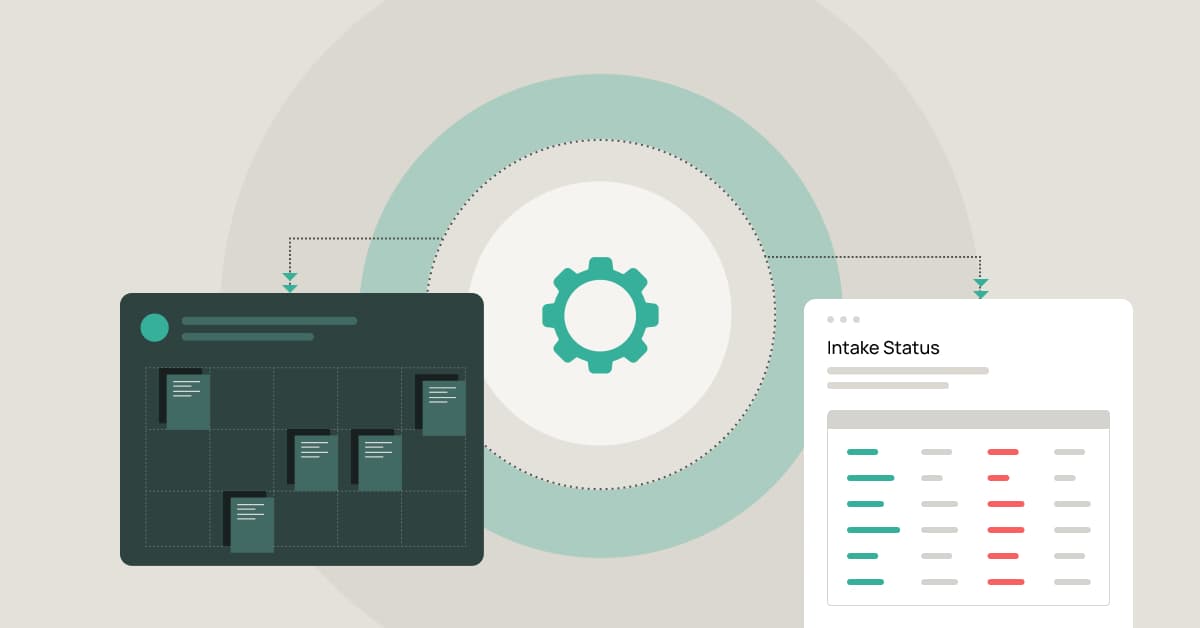Personal injury law firms manage a constant flow of client calls, medical records, deadlines, and negotiations. Without a system, it’s easy for important details to slip through the cracks.
Workflow management creates order for your firm by structuring the way cases move through your office. When supported by workflow automation, it turns routine tasks into predictable, reliable processes. For personal injury practices, that means cases move more smoothly, clients are kept informed, and your team can focus on higher-value work.
Contents
What workflow automation looks like
Workflow automation uses technology to handle repetitive tasks. Instead of manually creating every document or relying on sticky notes for deadlines, automation ensures the right steps happen at the right time.
- Client intake: Online forms feed directly into your case management system, automatically creating a new intake.
- Task lists: Your workflow triggers tasks and assigns them automatically to the team, tailored by case type.
- Reminders: Deadlines for statutes of limitation, hearings, or filings generate automatic alerts.
- Client updates: Case milestones can be easily communicated to clients through your client messenger system, ensuring timely and informative updates.
The result is a consistent process that minimizes errors and keeps cases moving forward.
How your firm benefits from workflow automation
Efficiency
Free up attorneys and staff by reducing manual tasks such as data entry and duplicate communications.
Accuracy
Automated reminders and task triggers reduce the risk of missed deadlines or overlooked filings.
Client Experience
Clients get timely updates and clear communication, which builds trust and confidence in your firm.
Growth Potential
Automation allows firms to handle a higher caseload without adding overhead, supporting long-term scalability.
How automation fits into personal injury workflows
Client Intake
Collecting client details is often the first bottleneck. With automation, intake forms sync directly with your management system, eliminating duplicate entry and creating an organized file from the start.
Document Management
Medical records, insurance correspondence, accident reports – PI cases generate enormous amounts of paperwork. Automated tagging and storage keep everything centralized and easy to retrieve, whether you’re in the office or in court.
Task and Deadline Tracking
Missing a statute of limitations or filing date can cost your client their case. Automation assigns tasks, tracks progress and alerts your team to upcoming deadlines, so nothing slips through the cracks.
Team Collaboration
Cases require collaboration between attorneys, paralegals, and staff. Workflow automation assigns responsibilities by role, tracks status in real time, and consolidates law firm communication into one system, reducing duplication and keeping everyone aligned.
Steps to implement workflow automation in your firm
Knowing the benefits is one thing – putting automation into practice is another. Here’s a simple roadmap your firm can follow:
1. Map Your Current Workflows
Start by documenting how cases move through your office today. From intake to settlement, note each step, who handles it, and where bottlenecks occur. This gives you a clear picture of what needs improvement.
2. Identify Repetitive Tasks
Look for tasks that eat up staff time but don’t require deep legal expertise. Common examples include:
- Data entry
- Client follow-up emails
- Deadline tracking
- Document preparation
3. Choose the Right Technology
Select a law firm workflow management system designed for personal injury practices. General legal software may miss the nuances of PI work. Using a system built for PI ensures features like statute-of-limitation tracking, medical record requests, and client messaging are ready to use out of the box.
4. Train Your Team
Introduce automation in stages and make sure your attorneys, paralegals, and support staff know how to use the tools. Provide training sessions, create reference guides, and set expectations – so everyone knows how to leverage automated tasks, reminders, and document management.
5. Monitor and Refine
Automation isn’t “set it and forget it.” Review your workflows regularly. Track performance metrics like case resolution times, client satisfaction scores, and staff workload. Use this data to fine-tune your processes.
By following these steps, your firm can move from scattered manual systems to a structured, automated approach that saves time and improves client service.
How CloudLex supports law firm workflow management
Many practice management tools exist, but few are designed specifically for personal injury firms – CloudLex is. Every feature was built with the demands of personal injury law in mind.
Here’s what sets us apart:
- Made for personal injury: Tools tailored to PI workflows instead of generic legal processes.
- Cloud-based access: Manage cases securely from anywhere, whether in court, at home, or traveling.
- Built-in automation: Intake, task assignments, deadlines, and reminders run automatically.
- Secure storage: Sensitive case and medical information are protected with enterprise-level security.
- Seamless integrations: Connect with the apps and services you already rely on, without extra steps.
Building a more client-focused practice
With higher client expectations, increasing caseloads, and strict deadlines, manual systems simply can’t keep up. By adopting structured law firm workflow management, your firm gains efficiency, accuracy, and scalability – resulting in smoother operations, stronger client relationships, and a more profitable practice.
See how CloudLex can simplify workflow automation for your personal injury firm. Schedule a demo today and take the first step toward smarter law firm management.


